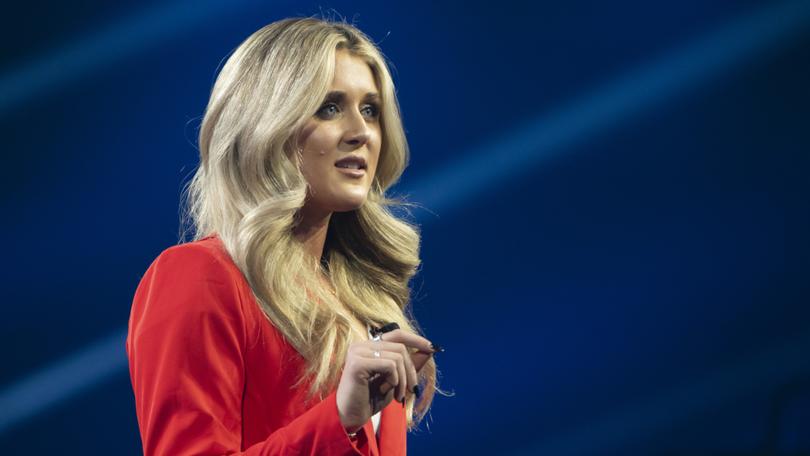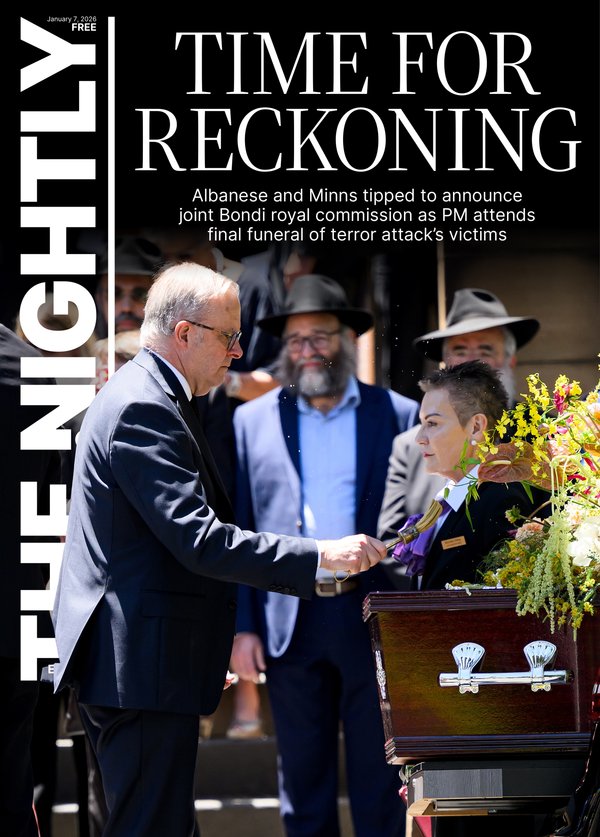THE NEW YORK TIMES: The voices young conservatives are listening to online

By the time former President Donald Trump joined TikTok in June, conservative content was flourishing on the social media platform, known for its grip on young people.
Trump’s TikTok account is part of an online conservative ecosystem characterised partly by videos, streams and messaging that rail against traditional institutions and promote a cultural ideology that pushes back on social movements supporting different gender identities and diversity, equity and inclusion.
That environment has affected many voters, particularly members of Generation Z, for whom Trump has been a consistent presence on presidential ballots since they became eligible to vote.
Sign up to The Nightly's newsletters.
Get the first look at the digital newspaper, curated daily stories and breaking headlines delivered to your inbox.
By continuing you agree to our Terms and Privacy Policy.The appetite for conservative-leaning content online inspired CJ Pearson, 21, a chair of the Republican National Committee’s Youth Advisory Council, to develop a digital initiative called Influence America.
It will involve a network of people popular on the right who will share Republican Party messaging on platforms such as TikTok and Instagram before the 2024 election. He plans to introduce Influence America in August.
“People follow people,” said Pearson, a veteran of the youth-focused conservative platform PragerU.
“They don’t follow organisations; they don’t follow parties.”

Historical voting patterns have shown that more young Americans are on the left or in the centre of the political spectrum. But some recent polls, including one released in July by The New York Times and Siena College, have shown Trump making inroads with registered voters younger than 30.
Other polls have shown that trust in traditional media, which is low with voters of all ages, is exceptionally poor among young voters.
To better understand what is resonating with young conservatives online, the Times asked 30 people between ages 18 and 30, all of whom identify as right-leaning, about the content they consume and the accounts they follow on social media.
Their answers reflected a preference for individuals who make bold and sometimes biased statements rooted in cultural and religious beliefs. While many expressed scepticism of the mainstream media, some said they relied on legacy outlets’ coverage of breaking news for information about events before going to their preferred sources for opinions.
Katherine Mickelson, 19, of Sioux Falls, South Dakota, said she would consult the Times, The Wall Street Journal or The Associated Press before seeking the accounts of people such as Matt Walsh and Brett Cooper, conservative commentators for The Daily Wire, and Riley Gaines, a former University of Kentucky swimmer who sued the NCAA after it allowed transgender women to participate in women’s college sports.
Even though some of the accounts that Mickelson follows online belong to people who cover politics, she sees the content they share as different from mainstream coverage.
For instance, she appreciates that Walsh “says outright ‘This is what I believe, and this is probably how it’s going to be biased,’” she said. (Among other positions, Walsh is known for taking an aggressive stance against LGBTQ+ rights.)
“Whereas other media sources will tell you they’re not biased, non-partisan,” added Mickelson, a student at Baylor University. “But clearly there are biases, and they do lean different ways.”
Nolan Jackett, a 21-year-old electrician in Richfield, Wisconsin, also follows staff members at The Daily Wire, a media company whose founders include right-wing pundit Ben Shapiro. He finds what they share “less scripted, more legitimately relatable” and “generally more conservative” than content from mainstream right-wing media personalities.
Leona Salinas, 19, who lives near Uvalde, Texas, said she liked how Cooper, 22, the host of The Daily Wire’s video series “The Comments Section,” critiqued progressive stances on social issues such as diversity and abortion. “She says what everybody is thinking and is too afraid to say,” said Salinas, a student at Texas State University.
Alex Mahadevan, who works to debunk misinformation as director of MediaWise at the Poynter Institute, a non-partisan non-profit organisation, said young people’s increased trust in the online chattering class rather than in the mainstream media was a problem because content creators, unlike most journalists, “are bound by no journalistic ethics.”
That pertains to people across the political spectrum: Hasan Piker, a popular left-leaning streamer on Twitch and YouTube, “shares as much misinformation as anyone on the right,” he added.
Mahadevan said the preference for content that affirmed beliefs stemmed from what he called a core human desire: the need for validation. “Confirmation bias and motivated reasoning are so powerful in humans,” he said. “We want to believe the facts that confirm what we think.”
Mahadevan added that the way some people selectively consumed mainstream news was exemplified after the shooting of Trump at a campaign rally in Pennsylvania last Saturday.
“Think about the most powerful image that came out of the event, and that is Trump bloody with his fist in the air with the American flag in the background,” he said.
“That was taken by an AP photographer. The AP is, like, the most traditional mainstream media.” But that hasn’t stopped people who claim to distrust the mainstream media from “taking that image and sharing it far and wide and saying this is the hardest image ever,” Mahadevan added.

Lucy Cox, 20, of Claremont, California, said she rarely saw examples of conservative women while growing up. That’s partly why she was drawn to Cooper and to Isabel Brown, a Gen Z streamer affiliated with the youth-focused conservative organisation Turning Point USA.
“I feel like there’s a lot of pushback with females being Republican,” Cox said. In a Gallup study released in March, only 21 [er cent of participating women between ages 18 and 29 identified as conservative, while 37 per cent identified as moderate and 40 per cent as liberal.
Cox valued the fact that Cooper and Brown often addressed less directly political topics, such as relationships. Both have given attention to the concept of tradwives, shorthand for traditional wives, which is based on the thinking that a woman’s place is in the home; Brown has also criticised hormonal birth control.
Cox, a student at the University of California, Berkeley, is not a fan of so-called situationships, a term for relationships without clear terms, or the rise of hookup culture, in which casual relationships are prioritised over meaningful ones. The women she follows online “bring a lot of attention to it and say, ‘Guys, this is not normal,’” Cox said. “That really resonates with me.”
Tristin Lollar, 22, of Jasper, Alabama, said he followed people online who didn’t shy away from sharing content that “rides the edge” of acceptable political discourse.
They include John Doyle, a YouTube host who was involved in efforts to overturn the 2020 election results, and Daniel Harris, a YouTube streamer known as the Rageaholic who has called the “narrative” of the Jan. 6, 2021, Capitol attack “a myth.”
Lollar said he appreciated that both were “expressing their true beliefs, no matter how problematic that may be.”
He added that he did not want Fox News pundit Sean Hannity or CNN news anchor Jake Tapper to tell him what he should think.
But Lollar, who is starting law school at the University of Alabama this fall, said he also believed President Joe Biden won the 2020 election. He said he knew that some of the right-wing accounts he followed had shared information that was not fact-checked.
“It does fall under free speech,” he said, acknowledging an argument often used to justify commentary that is divisive and not based in facts. “But on the other end of the spectrum, it’s like, shouldn’t you be more responsible knowing that you have an audience full of people who are very impressionable?”
Lollar hopes that the attempted assassination of Trump “serves as a wake-up call for alternative media outlets and creators to refrain from incendiary rhetoric,” he said, and that it will encourage “peaceful dialogue between all sides going forward.” Other young conservatives echoed these sentiments.
Ebo Entsuah, 30, of Clermont, Florida, said he looked for nuanced content in a media ecosystem full of polarisation and hot takes. “I look for somebody who’s not just trying to ‘own the libs,’” he said, naming Brad Polumbo, a gay, right-leaning commentator who identifies as libertarian, as among those he follows.
Entsuah, a former City Council member in Clermont who has worked for Florida Gov. Ron DeSantis, added that he looked for people who were not afraid to call out statements that were false or misinformed. “That’s not just on the Democratic side, but on the Republican side as well,” he said.
This article originally appeared in The New York Times.
© 2024 The New York Times Company
Originally published on The New York Times
